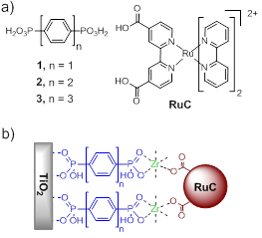Modulating Electron Transfer Dynamics at Hybrid Interfaces via Self-Assembled Multilayers
Electron transfer at organic-inorganic hybrid interfaces is a critical event in bio/organic electronics, solar energy conversion, electrocatalysis, sensing and other applications. At the interfaces in these devices, the goal is to maximize the rate of electron transfer in one direction (forward electron transfer, FET). Equally important is the inhibition of the back electron transfer (BET). We have introduced the use of a molecular bridge in self-assembled bilayer films as an effective strategy for modulating electron transfer dynamics at the semiconductor-molecule interface. The bilayer films of the general form MO-(X)-Zr-moelcule are composed of a metal oxide electrode (MO; TiO2 or SnO2 for example), a bridging molecule (X), linking ions (Zr, Zn, etc.) and a molecule. One example bilayer with TiO2, a bridging molecules 1, 2 or 3, Zr4+ ions and RuC ([Ru(bpy)2(4,4'-(COOH)2bpy)]2+) is depicted in Figure. This approach offers a simple and modular method for slowing BET between any dye molecule and the semiconductor interface. Additionally, as opposed to other methods of slowing BET, like atomic layer deposition or synthetic modification, the step-wise soaking/loading procedure is amenable to roll-to-roll printing for large scale manufacturing of devices. Controlling electron transfer rates will help to decrease photocurrent leakage and improve device performances.


